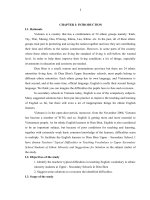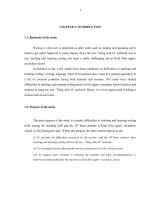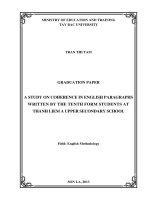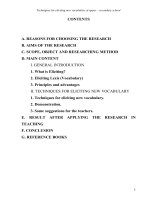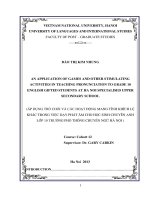skkn theme ((techniques for eliciting new vocabulary at upper – secondary school
Bạn đang xem bản rút gọn của tài liệu. Xem và tải ngay bản đầy đủ của tài liệu tại đây (622.79 KB, 33 trang )
Techniques for eliciting new vocabulary at upper – secondary school
CONTENTS
A. REASONS FOR CHOOSING THE RESEARCH
B. AIMS OF THE RESEARCH
C. SCOPE, OBJECT AND RESEARCHING METHOD
D. MAIN CONTENT
I. GENERAL INTRODUCTION
1. What is Eliciting?
2. Eliciting Lexis (Vocabulary)
3. Principles and advantages
II. TECHNIQUES FOR ELICITING NEW VOCABULARY
1. Techniques for eliciting new vocabulary.
2. Demonstration.
3. Some suggestions for the teachers.
E. RESULT AFTER APPLYING THE RESEARCH IN
TEACHING
F. CONCLUSION
G. REFERENCE BOOKS
1
Techniques for eliciting new vocabulary at upper – secondary school
A. REASONS FOR CHOOSING THE RESEARCH
Vocabulary is one of the important aspects of language to teach.
There are many quotations from famous linguistics to support this
idea. For example, "Without grammar very little can be conveyed;
without vocabulary nothing can be conveyed." (Wilkins 1972:111)
and "When students travel, they don't carry grammar books, they carry
dictionaries." (Krashen in Lewis 1993: iii). Moreover, errors of
vocabulary are potentially more misleading than those of grammar.
Sometimes the context of the utterance would lead a listener to
question their first interpretation, but a chance response such as "Yes,
my father has an affair in that village'(confusing the Swedish affar
meaning 'shop' with the English 'affair' which can mean 'extra-marital
relationship') gives the listener the wrong impression. From above,
you will see the importance of vocabulary. Hence teachers should
know how to present vocabulary effectively in order to help student
develop vocabulary.
B. AIMS OF THE RESEARCH
- To introducing eliciting new vocabulary and showing its
benefits.
- To show ways of eliciting new vocabulary.
- To show how new vocabulary can be presented for various
classroom activities.
- To draw out what the learners know through their relationship
to the words they understand.
C. SCOPE, OBJECT AND RESEARCHING METHOD
2
Techniques for eliciting new vocabulary at upper – secondary school
- Scope : Researching in the process of teaching English at Le
Hoan upper-secondary school.
- Object: This subject is concerned with ways of organizing
activities in the class.
- Researching method: Reading reference books , discussing
with other teachers, applying in teaching, observing and drawing out
experiences.
D. CONTENT
I. GENERAL INTRODUCTION
1. What is Eliciting?
Synonyms: searching, drawing out, discovering, realizing,
understanding. Eliciting is a technique used by the teacher during the
lesson that involves the language learner in the process of discovering
and understanding language.
Anything in the lesson can be elicited: vocabulary, grammar,
experiences, and ideas. The objective of eliciting is to allow the
learners the chance to participate in the learning process by letting
them express their acquired or intuitive knowledge, and through
critical thinking which will enhance their language abilities by adding
to what they already know.
To understand what effective eliciting is, it will help to know
what it is not. Eliciting is not asking, “What does ________mean?” It
is not a “you should know this” question similar to that used by a
teacher in an academic setting. It is not a vague, trivia-based question
in which the learner must provide some definition similar to a word
3
Techniques for eliciting new vocabulary at upper – secondary school
game or puzzle. Eliciting draws out what the learners know through
their relationship to the words they understand. But further than that, it
allows the teacher to see what the learner knows, and so permits the
teacher to add to their knowledge.
The key to successful eliciting lies in an artful interaction
between the teacher and the learner. There is no special time for
eliciting to occur during the lesson. It can be used as needed—during
any of the engage, study and activate sections of the lesson.
2. Eliciting Lexis (Vocabulary)
Let’s say that there is a text about the common cold. Let’s say
you want to present this reading to your learners. How can you
prepare them to wholly understand the text? By engaging them
through eliciting, you can start talking about health in general and then
more personally and specifically: For example, the teacher elicits:
What kinds of health problems are common in most people?
What kinds of common health problems do you suffer from?
Within text, you will need to determine the key lexis or
vocabulary for this reading. You will decide on the key lexis based on
your knowledge of your learners and what you feel is essential for
them to understand, before they read, in order to get the gist of the
text. Some of the words they may already know, some may be new to
them. Whatever the case, you will try to get your learners to use these
words in order to show they understand them. Otherwise, you can use
them yourself interactively through discussion of the theme, by asking
questions and using the key words in context.
4
Techniques for eliciting new vocabulary at upper – secondary school
For the example of a text on the common cold, you could start
by having your learners will start out by providing you with some of
the basic, general language about common illnesses words and
phrases they know already. You can write these words and phrases on
the board as they bring them up, organizing them into parts of speech:
nouns, adjectives, verbs, etc. Later, you’ll be able to erase all but the
key words located in your text.
For example, let’s assume that most of your learners know the
words “a cold” and “a virus”, but you aren’t sure they know the verb,
“to spread”. The teacher elicits:
A virus can spread colds. What other illnesses can be spread?
Assuming the learners already know the meaning of colds and/or
virus, they can deduce the meaning of SPREAD from context. If the
teacher adds a gesture to show SPREAD (I.e., using your hands to
sweep across the room is a spreading gesture), then the learners will
most certainly access meaning.
The teacher shouldn’t assume, however, that the learners have
understood the word(s) by the assent of the learners (by their saying
only the word, or merely nodding their heads). The teacher will then
want to CONCEPT CHECK meaning by asking something like,
“What other illness can be spread?” The teacher should expect to hear
something like, “the flu can be spread, or malaria, or AIDS.” By doing
this, the teacher ensures that everyone has understood its precise
meaning (see Concept Checking).
5
Techniques for eliciting new vocabulary at upper – secondary school
Eliciting is often used to pre-teach key vocabulary (words that
will appear in the study and activate stages of the lesson). In doing this
stage interactively, with the teacher and the learners collaborating and
negotiating language (teacher draws out, learners discover, and
together you arrive at understanding), the learners will more likely
hold onto the meaning of these words not only in the lesson, but
beyond it.
Effective eliciting of lexis can enhance the learners’ overall
understanding of a lesson, especially in reading and listening lessons.
Effective ways to elicit:
Ask, “What is another way to say ______?” For example: What
is another way to say that you are very, very hungry? (I'm starving)
Provide a simple definition. For example: It is something that
we drink hot coffee and tea out of. (a mug)
Act it out. For example: Wipe your brow and pretend to fall.
Then ask, “What did I do?” (I fainted)
Ask, “What is the opposite of ______?” For example: What is
the opposite of tall? (short)
Use a visual. For example: Shoe a picture of two people who
look the same and ask, “What do we call two people who look the
same?” (identical twins).
3. Principles and advantages
Eliciting is based on several premises:
6
Techniques for eliciting new vocabulary at upper – secondary school
Collectively, students have a great deal of knowledge, both of
the language and of the real world. This knowledge needs to be
activated and used constructively.
The teaching of new knowledge is often based on what the
learners already know.
Questioning assists in self-discovery, which makes information
more memorable.
Eliciting helps to develop a learner-centred classroom and a
stimulating environment, while making learning memorable by
linking new and old information. Eliciting is not limited to language
and global knowledge. The teacher can elicit ideas, feelings, meaning,
situations, associations and memories. For the teacher, eliciting is a
powerful diagnostic tool, providing key information about what the
learners know or don't know, and therefore a starting point for lesson
planning. Eliciting also encourages teachers to be flexible and to move
on rather than dwell on information which is already known.
II. TECHNIQUES FOR ELICITING NEW VOCABULARY
What’s your favorite way to elicit new vocabulary? Do you
mime, or draw, or do something else? Please share in the
comments below!
1. Techniques for eliciting new vocabulary.
1.1. Opposites
This works for certain adjectives, verbs, nouns, adverbs,
determiners etc, e.g. “What’s the opposite of dark/ stop/ an idiot/
suddenly/ few?”
7
Techniques for eliciting new vocabulary at upper – secondary school
1.2. Ranks, sequences and sliding scales
We can extend the idea of giving opposites to include things that
could be written with two opposites as steps on a scale, e.g. (words
you are trying to elicit in brackets) “What comes next? Cold, hot,
(boiling)/ Dislike, like, (love)” This can be extended to anything else
that could be seen to have some kind of sequence such as “pupil,
undergraduate, (graduate)”, “tap, hit, (bash)” or “today, yesterday, (the
day before yesterday)”.
1.3. Similarities
This is another good way of eliciting “the day before yesterday”-
“If tomorrow is followed by the day after tomorrow, what is yesterday
preceded by?” This works for word forms (e.g. “the noun of ‘act’ is
made the same way as the noun for ‘connect’ that we learnt last
week”) and similarities inspelling and pronunciation (e.g. “It has the
same spelling/pronunciation/grammatical form as ‘bought’”).
1.4. Definitions
This is the technique that new teachers tend to use most often
and most naturally. This is perhaps because we often use it when we
really can’t remember a word or name in our own language and are
hoping the person we are speaking to can come up with it or at least
understand what we are talking about anyway, as in “I need one of
those, what do you call them? Things to get your car off the ground so
you can change a tyre” “A jack?” “Yes, that’s it.” You can make the
definitions you use to elicit in class easier to come up with and
understand by writing all the definitions you are going to use on your
8
Techniques for eliciting new vocabulary at upper – secondary school
lesson plan, taking them straight out of a dictionary or the teacher’s
book, writing the definition up on the board as well as or instead of
saying it, or only using words they should know at that level (perhaps
from a vocabulary list) when writing definitions. You might also want
to have a plan B definition in case the first one is not understood or is
confused with another word.
1.5. Synonyms
If you are lucky, you won’t need to go through a whole long
definition if there is a word that means approximately the same (it
doesn’t always matter if it is not an exact synonym as long as it
produces the word you want, but make sure that it doesn’t reinforce
their wrong idea that two different words are the same). You can
increase your chances of using this method successfully and often by
getting the students used to doing exercises on synonyms in class and
for homework. If there are several synonyms, you might want to
check with a teacher with more knowledge of students with that L1
which of them is more likely to be familiar because it is similar to
their own language, is more often studied in the school system, is part
of a well known product name etc.
1.6. When we talked about it before
Another method we use naturally in our normal speech we can
exploit in the classroom is “Who was that actor we were talking about
yesterday? You remember, when we were talking about films that we
hate. That’s right, Beat Takeshi. Well, he…” with variations like
“Remember the word everyone had problems with in the test?” and
9
Techniques for eliciting new vocabulary at upper – secondary school
“What was the word for the kind of shop that we did a roleplay about
last week?”
1.7. Memory
The idea of getting them to remember things to elicit words can
be extended to, for example, seeing if they can remember a word from
a dialogue they have just been doing, e.g. “What was the third product
he asked for in the shop?”
1.8. Gaps
This could mean a word with letters blanked out, a typical
sentences with the word or expression you are trying to elicit blanked
out, or a combination of the two, e.g. “He let the c_t out of the bag”.
This can be used with spoken elicitation as well as written elicitation
by humming the missing part of the sentence.
1.9. Stress clues
By humming the rhythm of the word or drawing its stress pattern
on the board, you can help students work out which of several similar
words you are trying to elicit from them.
1.10. Multiple choice
You can really go for it with giving clues by telling students
options they can choose from, although if you have chosen this
method because students actually have no idea of the answer this
makes it more of a presentation than an elicitation.
1.11. Brainstorm
Although not many people think of it this way, brainstorming is
basically a form of eliciting but without the words you want them to
10
Techniques for eliciting new vocabulary at upper – secondary school
come up with necessarily being defined. A brainstorming stage can
then be moved onto a more traditional elicitation by showing them
which of words they have already given you is most similar to the one
you want.
1.12. Spider diagrams/ Mind maps
Brainstorming can also be done in a more organised manner
with words being added to categories and subcategories like the
branches and twigs of a tree. You can then point to the place where
the word you want to elicit would be if it was on that mind map, using
other elicitation methods to help them work out which of the
possibilities that could be there you are thinking of.
1.13. Common mistakes
Another technique that teachers don’t often think of combining
with elicitation is talking about errors, but in fact giving hints about
what mistakes students make with a word or expression can be a great
hint about which one you are thinking of (e.g. “People often confuse it
with ‘butter’, but it has flour and is put on something that you deep
fry” for “batter”, or “Spanish speakers often think it means pregnant,
but it actually means ashamed” for “embarrassed”). This technique
can also lead onto talking about subjects like false friends,
pronunciation mistakes, negative and positive connotations (“People
who call someone fat should probably use this word that we learnt last
term instead”) and formality mistakes (“Although some people write
‘hello’ at the beginning of a business email, the word we want starts
with ‘d’ and is…?”)
11
Techniques for eliciting new vocabulary at upper – secondary school
1.14. Visuals
Just like your students when they get totally stuck
communicating in English during their travels, you might find that a
quick sketch is the only way to get them to understand and produce
the word or expression that you mean. In you think a picture might be
the best way of explaining something, you also have the option of
using a flashcard or a printout from the internet (try searching in the
images option of Google).
1.15. Multimedia
If you have internet access in the classroom, there is also the
option to just search for an image as the topic comes up (as long as the
students can’t see the search terms you are using, as this means there
is nothing left to elicit!) Using video takes a lot more preparation, but
you could use a very short clip to elicit the name of something you
can see on a video, or even something that is going to appear but
hasn’t yet.
2. Demonstration
Visuals:
Examples 1: A car
A4 card or blackboard
Examples 2: Athletic
Magazine picture
Mime
12
Techniques for eliciting new vocabulary at upper – secondary school
Example: cold
T: mimes feeling cold
T. asks, “How do I feel?”
Example: (to) fly a kite
T. mimes flying a kite
T. asks, “What am I doing?”
Realia
Example: bananas (count.), rice (uncount.)
T. brings real bananas and rice into class.
T. asks, “What’s this?”
Example: open (adj), closed (adj)
T. opens and closes the door.
T. says, “Tell me about the door: It’s…what?”
Situation/ Explaination
Example 1: honest
T. explains, “I don’t tell lies. I don’t cheat in the exam. I tell the
truth.”
T. asks, “What am I? tell me the word in Vietnamese.” Good.
Now listen to it in English “Honest”.
Example 2: Furniture:
T. lists examples of furniture: “Table, chairs, beds – these are
all….(Furniture)…. Give me another example of….(Furniture).
Example 3: (to) complain.
T. says, “The bed is too hard. I don’t like it. The room is too
small. It’s no good, etc.”
13
Techniques for eliciting new vocabulary at upper – secondary school
T. asks, “What am I doing?”
Synonym/ Antonym
Example 1: Intelligent
T. asks, “What’s another word for clever?”
Example 2: stupid
T. asks, “What’s the opposite of clever?”
Translation
Example: (to) forget
T. asks, “How do you say “quên” in English?”
2. Some suggestions for the teachers
Each teacher has ways to teach new words. Whatever teaching
style are used the suggestions which may help teachers are followings:
2.1. Teacher has to prepare the way to show meaning. For
example, if the words which the teacher is going to present are
concrete, the teacher should prepare picture of those words to
present.
2.2. Teacher has to ask students to tell the meaning first in
order to elicit meaning from students before they offer the meaning.
2.3. Teacher has to think about how to show the meaning of a
word with related words such as synonyms, antonyms etc.
Moreover, the example words should be the word that students are
already known.
2.4. Teacher has to think about how to check students'
understanding.
14
Techniques for eliciting new vocabulary at upper – secondary school
2.5. Teacher has to think about the context in real situation
where the words might be used in order to relate learning language
to real life and also promotes high motivation.
2.6. Teacher should review the vocabulary via a game or
activity in order to motivate them in learning.
2.7. Teacher should give them some assignment by telling
them to read, watch films, listen to songs etc and note the useful
word. It is a good way to study vocabulary by themselves.
2.8. Teacher should have a section of board for vocabulary
items that come up while teacher are teaching. Use different colours
for the word / the phonetics /the part of speech.
2.9. It is a good idea to teach vocabulary with associated
meanings together.
2.10. Teacher should encourage students to use a good
dictionary.
2.11. Whenever the student asks the word that has never
heard of the word, you tell the student that you will check and get
back to them later.
2.12. Teacher should enough examples sentences to make
sure that the students understand what the teacher taught and give
extra example if the students are unsure and encourage them to
write the word in an example sentence.
E. APPLYING THE RESEARCH IN TEACHING
15
Techniques for eliciting new vocabulary at upper – secondary school
Unit 9: Deserts
Lesson 1: Reading
Class: 12A1, 12A6, 12A11.
I. Objectives
By the end of the lesson Ss will be able to:
- understand the passage about deserts and scan for specific
information.
- use vocabulary related to the topic of the lesson through
exercises.
II. Teaching aids
- Textbook, chalk, posters, pictures.
III. Procedures
TEACHER’S ACTIVITIES STUDENTS’ ACTIVITIES
I. WARM – UP ( 5 min.)
- Ask Ss to look at pictures in
their textbooks and discuss the
questions below
Discuss and answer the
questions
16
Techniques for eliciting new vocabulary at upper – secondary school
1. What is the name of the
animal?
2. Where does it live?
3. How are deserts?
4. Name some deserts (Sahara,
Simpson, Gobbon )
* Introduce the title of the lesson
U9: DESERTS
Today we're going to read about
Simpson desert.
II. PRESENTATION ( 35 min.)
1. Pre- reading: Guess the
meaning of some words
Vocabulary:
- to comprise :
- enormous (adj)
- mystery (n)
- corridor (n):
- stable (a)
- shrubland (n)
elicits the new words:
Answers' suggestion:
1. It is a camel
2. It lives in deserts
3. They are dry, hot. Dunes are
around deserts.
4. They are: Sahara, Simpson,
Sonoran (Bac My), King
Canyon (Uc)
- Ss pay attention and answer
the questions.
II. PRESENTATION
- Ss pay attention and take
notes
17
Techniques for eliciting new vocabulary at upper – secondary school
a. (to) comprise: T. uses
synonym to elicit the verb.
(to) comprise: “(to) include or
(to) consist of”
T. asks “What does it mean in
Vietnamese?”
b. enormous (a):
T. uses synonym to elicit the
word.
“enormous”: extremely large.
T. asks “What does it mean in
Vietnamese?”
c. mystery (n):
T. uses explaination to elicit the
word.
“Mystery” means something
secret.
T. asks Ss, “What does it mean in
Vietnamese?
d. corridor (n)
T. uses visual aids (a picture of a
corridor)
- Ss answer: bao gồm.
- Ss answer: Khổng lồ, to lớn.
- Ss answer: Điều bí ẩn
18
Techniques for eliciting new vocabulary at upper – secondary school
- T. asks “What can you see in the
picture?”
- T says “Yes, it is. So Corridor
means “hành lang”
e. stable (a):
T. uses explaination to elicit the
word.
Stable means “not likely to move
or change”
- T. asks “What does it means in
Vietnamese?”
f. shrub-land:
- T. uses translation.
shrub-land: vùng đất có nhiều cây
bụi.
* Rub out remember
2. While reading :
Task1: Give the Vietnamese
equivalents to the following
words or phrases
- Ask students to read through the
- Ss answer: Một hành lang nhà
- Ss answer: ổn định , cố định.
Task 1: Checking the
vocabulary : Matching (a
poster)
19
Techniques for eliciting new vocabulary at upper secondary school
text once to find out some new
words, guess the main idea.
- Ask Ss to read the passage
silently, stop when they meet a
new word or a phrase and find
words or phrases in the passage
which have the following
meaning given in the Task 1.
- Give feedback.
Task 2: Decide whether the
following statements are true (T)
or false (F):
- Guide Ss the way to do Task 2
A (English) B (Vietnamese)
- 'aerial servey
- dune
- sloping
- hummock
Australian
Aborigine
- crest
- spinifex
- stretch
-Royal
Geographical
Society of
Australia
- steep
- Sandy
- cuộc khảo sát
trên không
- đụn cát. cồn
cát
- dốc
thoai
thoải
- gò , đống
- thổ dân úc
- đỉnh , nóc
- cỏ lá nhọn
- kéo dài, căng
ra
- Hội địa lí
hoàng gia Uc
- dốc đứng
- có cát
Task 2:
20
Techniques for eliciting new vocabulary at upper – secondary school
and ask them to work in pairs
- Get Ss to check theirs answers
and explain their choices.
- T calls on some Ss to read theirs
answers and explain their choices.
- T comments and gives
feedbacks.
Task 3: Answer the following
questions
- Ask Ss to read the passage
silently and answer the questions
individually
- Ask Ss to work in pairs to
compare their answers.
1. F (There are five: the Great
Victoria, the Gibbon, Great
Sandy, Tanami and Simpson)
2. F (Simpson is the last part
of Australia.
3. T (Until Madigan made an
aerial survey in 1929, he )
4. F (Colson and Australia
Aborigine)
5. F (In the western , there is
a network of short dunes, and
in the northern part , the
dunes are )
6. T (In the northern dry
salt lakes )
Task 3:
1. There are Great Victoria
Deserts, Gibbon, Great Sandy,
Tanami deserts and Simpson
Deserts.
2. It lies between Lake Eyre in
21
Techniques for eliciting new vocabulary at upper – secondary school
- Call on some Ss to write the
answers on the board.
- Check with the class.
- Give feedback.
3. Post reading: * Read this story
and answer the questions.
- Ask Ss to work in pairs
- Go around for help
- Call on some pairs to present
- Give comments .
III. CONSOLIDATION &
the south, the Macdonnel
Ranges in the north, the
Mulligan and the Diamantia
Rivers in the east and the
Macumba and Finke Rivers in
the west.
3. In 1845
4. He was the president of the
South Autralian Branch of the
Royal Geographical Society of
Australia.
5. They took camels across the
desert.
6. In the west part, they are
short, mostly less than 10
meters high, and in the northern
part, they are parallel and are
up to 20 meters high.
7.Two. They are hummock
grasses and spinifex.
- Ss read the story silently,
individually and answer the
following questions.
1. I think it is funny
22
Techniques for eliciting new vocabulary at upper – secondary school
HOMEWORK ( 5')
- Learn vocabulary
- Prepare section B - SPEAKING
2. dessert (mãn tr¸ng miÖng)
and desert (sa m¹c)
- Do exercise at class
UNIT 11: NATIONAL PARKS
Lesson 3 – LISTENING
Class: 10A2
I. Objectives:
1. Knowlege: After the lesson students are able to understand the
information about Cuc Phuong National Park
2. Skills: Help the students to practise listening main ideas and getting
the information about Cuc Phuong National Park to do the multiple
choice practice.
3. Attitudes: Motivate students, help them take interests in the subject
and be aware of the conservation.
II. Preparation:
1. Teacher’s preparation: Textbook, pictures, chalks, lesson-plan,
handout
2. Students’preparation: Textbooks, pens, pencils
III. Procedure:
1. Check the previuos lesson.
Lead to the new lesson
Teacher’s activities Students’ activities
WARM UP (4’)
23
Techniques for eliciting new vocabulary at upper – secondary school
- Ask Ss to work in groups close
your book and answer question:
Write down some names of National
Parks In Viet Nam?
- Give comments and present new
lesson: Unit 11 (cont) – C.
Listening
- Work in groups to answer:
Suggested answers:
Cat Ba, Cat Tien, Cuc
Phuong , U Minh, ……
2. The new lesson
Teacher’s activities Students’ activities
I – BEFORE YOU LISTEN (10’)
Introduce the new lesson: You are
going to listen to a passage about
Cuc Phuong National Park.
-Ask Ss to work in pairs to discuss
the following questions:
1. Where is Cuc Phuong National
Park?
2. What is the area of the rainforest
in Cuc Phuong National Park?
3. When is the best time to visit Cuc
Phuong National Park?
4. What can be seen in Cuc Phuong
National Park?
- Go around helping if necessary.
- Call on some to answer out loud.
- Give comments and correct
- Work in pairs to answer
questions:
Suggested answers:
1. It is south west of Ha Noi.
2. It contains over 200 square
kilometers of rainforest.
3. It is during the dry season,
from October to April, when
rainy season is over.
4. Butterflies, caves,
mountains and 1000-year old
trees can be seen there.
24
Techniques for eliciting new vocabulary at upper – secondary school
answers.
- Elicit some of the words given in
the book or those taken from the
listening passage.
threatened and endangered
species:
ethnic minority:
flora (n)
fauna (n)
defeat (v)
a. Threatened and endangered
species
T. uses explaination to elicit the
phrase.
“Tigers, lions, elephants, etc. are
threatened and endangered species.”
T. asks “What does the phrase
mean?”
b. ethnic minority (np):
- T uses visual aids and asks “who
are they in Vietnamese?”
- Give the answers.
- Listen and write down.
- Ss answer: Các loài bị đe
dọa và nguy hiểm
- Ss answer: Người dân tộc
thiểu số.
25


